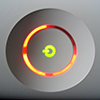Microsoft's Xbox 360 goes 65nm: Falcon Dissection and Power Consumption
by Anand Lal Shimpi on November 15, 2007 11:55 PM EST- Posted in
- Smartphones
- Mobile
The Red Ring of Death
 Earlier this year, Microsoft announced an extension of the Xbox 360's warranty from 1 to 3 years for consoles affected by the infamous Red Ring of Death (RRoD) defect. Microsoft never confirmed what actually caused the RRoD, or how many consoles would ultimately be affected, but the symptoms are very well known. Your console will start to freeze/lock up, eventually followed by three red lights on the front of the system, after which you'll either be able to revive the box for short periods of time or it becomes an expensive piece of modern art.
Earlier this year, Microsoft announced an extension of the Xbox 360's warranty from 1 to 3 years for consoles affected by the infamous Red Ring of Death (RRoD) defect. Microsoft never confirmed what actually caused the RRoD, or how many consoles would ultimately be affected, but the symptoms are very well known. Your console will start to freeze/lock up, eventually followed by three red lights on the front of the system, after which you'll either be able to revive the box for short periods of time or it becomes an expensive piece of modern art.
The present solution to RRoD is pretty simple; you call Microsoft's support hotline, you give the representative some information about your Xbox 360 (he/she will then walk you through some diagnostic steps, nothing too painful), and a few days later you'll find an empty box at your doorstep. Toss in your Xbox 360, affix the pre-paid shipping label (Microsoft even provides tape to seal the box) and about a month later you'll get a refurbed or brand new Xbox 360, as well as a 30-day pass for Xbox Live. While you're without your console for as much as a month, at least there's no cost incurred; overall Microsoft takes care of RRoD victims quite well.
Many have surmised that the reason for the RRoD problems is because of inadequate GPU cooling, resulting in fractures in the lead-free solder between the chip and the motherboard. We haven't been able to confirm this suspicion but we have been able to find evidence that Microsoft ignored many suggestions to improve GPU cooling in the Xbox 360, although we're not sure why.
Simply looking at the Xbox 360's internals you see that there's something wrong with the cooling setup; the heatsink covering the GPU, albeit wide, is barely large enough to cool a low end desktop graphics card, much less the higher powered GPU that's in the Xbox 360. If we assume that the Xbox 360's GPU is at least as powerful as the PS3's, the cooling requirements should be somewhere similar; given that the PS3 basically had a GeForce 7800 GTX under its hood, the cooling requirements should be similar. What would require a two-slot cooling solution in a desktop PC was given a barely adequate heatsink on the Xbox 360 and stuck underneath a DVD drive.
Despite the seemingly inadequate cooling, the Xbox 360 worked just fine - the exception being what seemed to be an inordinate amount of RRoD failures, but since Microsoft extended the warranty it wasn't a huge problem, just more of an annoyance.
It's possible that simple tweaks in the manufacturing process could reduce the likelihood of RRoD, assuming that it is heat related. As yield curves improve over the life of manufacturing a particular chip, it is possible to produce chips that run at lower voltages and are thus cooler. It could very well be that the consoles that fail due to RRoD are simply using higher yield GPUs that run at higher voltages, and thus produce more heat, explaining why the problem seems to affect some consoles but not others. If this correlation were true, as overall chip yields improve, the chances of RRoD go down.
When rumors began creeping up about Microsoft moving to 65nm chips in the Xbox 360, many wondered if this could be the end of the RRoD problems, saving owners the headache with dealing with potential failure. Assuming that the root cause of RRoD is inadequate cooling, it is feasible that moving to cooler chips could alleviate if not altogether fix the problem.
While there's no conclusive way of proving whether or not these new Xbox 360s will reduce the chances of the dreaded RRoD, the geek in us couldn't help but try to go find one of these babies, test it and take it apart.










46 Comments
View All Comments
Locutus465 - Friday, November 16, 2007 - link
I too was wondering about heat durring operation... Is there no way to gage this? I know it won't be totally accurate at the core level, but still relitive heat off the heat sink has got to tell you something.jamesbond007 - Friday, November 16, 2007 - link
Does the same techniques for identifying a Falcon-based 360 work on the Elite and Halo Edition consoles?Anand Lal Shimpi - Friday, November 16, 2007 - link
Yes the same flashlight techniques work, although the lot numbers may not correspond. The Halo 3 edition consoles seem to have to be lot 734 or later *and* be built after 8/24. I had the best luck getting a Premium console with a lot 738 or later.Take care,
Anand
Voidberg - Wednesday, June 8, 2011 - link
I know i some how fucked this up but i have a falcon mptherboard with a heatpipetipoo - Monday, December 12, 2011 - link
Falcons have a heatpipe connecting the two GPU heatsinks, just not in the CPU heatsink anymore.Voidberg - Wednesday, June 8, 2011 - link
Google it the power supplys are diff and man up and open the xbox